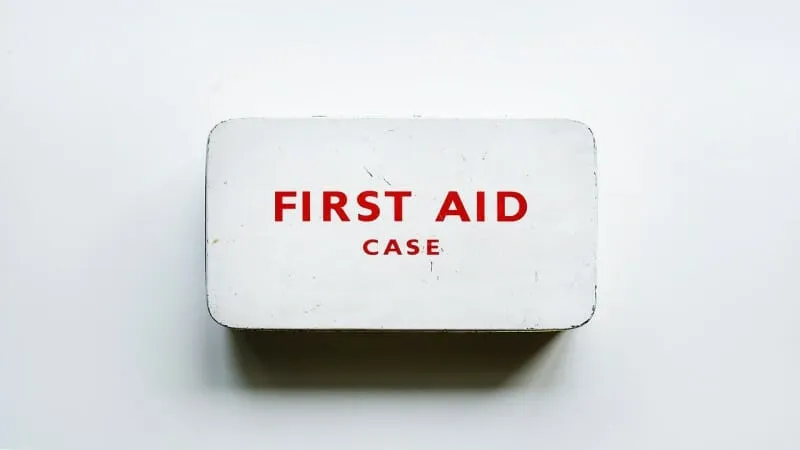
Last Updated On: noviembre 4, 2024
When medical emergencies arise, knowing those first few steps can make a huge difference. First aid isn’t just something doctors need. It’s something everyone needs to learn. Yet, according to the World Health Organization, less than half of us feel confident in providing first aid. That’s a wake-up call, showing just how important it is for everyone to understand a few basic steps.
First aid is more than just a fix until professional help arrives. Whether it’s a small cut or something more serious, knowing first aid means you can act fast, bring comfort, and even save a life. This guide will give you the basics of first aid.
In an emergency, it’s easy to feel overwhelmed, especially when someone has multiple injuries. But staying calm and thinking through the steps can make all the difference. First, check for any dangers around the injured person or yourself. Once you’re sure the area is safe, look for any life-threatening injuries, like heavy bleeding, trouble breathing, or unconsciousness. These need to be treated right away.
To stay focused, you can follow the «ABCDE» method: Airway, Breathing, Circulation, Disability, and Exposure. When providing First aid for injuries, This order helps you tackle the most serious issues first. For example, make sure the person’s airway is clear and they’re breathing before handling minor cuts. By sticking to these steps, you’ll be able to provide calm, effective help when it’s needed most.
Treating open wounds right away helps prevent infection and speeds up healing. First, gently press on the wound with a clean cloth to stop the bleeding. This step controls blood loss and gives you time to get ready for more care. When the bleeding slows, rinse the wound with cool water to clean it. Avoid using strong chemicals like hydrogen peroxide or alcohol since these can irritate and slow down the healing process. Cleaning the wound well helps keep out bacteria and promotes faster recovery.
After cleaning, apply a little antibiotic ointment and cover the wound with sterile gauze or a bandage. This protects it from dirt and germs. Be sure to change the dressing every day or anytime it gets wet to keep the wound fresh and lower the risk of infection. Finally, keep an eye out for signs of infection, like redness, swelling, or discharge. These simple steps go a long way in first aid, helping prevent complications and supporting good healing.
Burns require specific care to prevent further damage to the skin. For minor burns, hold the affected area under cool running water for at least 10 minutes to soothe pain and lower skin temperature. Avoid using ice, as it can cause additional tissue damage. After cooling the burn, cover it with a clean, non-stick bandage. Severe burns, on the other hand, should be loosely covered, and immediate medical help should be sought. Correct burn treatment can ease pain, prevent infection, and minimize scarring.
Fractures and sprains each need special handling to avoid worsening the injury. When dealing with Burns and fractures care, immobilize the area using a homemade splint if a professional one is unavailable. For sprains, the RICE method: Rest, Ice, Compression, and Elevation. It offers a comprehensive approach to managing pain and swelling. While these injuries may not be life-threatening, proper care can significantly speed up recovery and reduce discomfort, making each step essential in first aid practice.
Shock can occur after serious injury or intense stress and may present symptoms like pale skin, fast breathing, and disorientation. To manage shock, keep the person lying down with their legs elevated to encourage blood flow to essential organs. Cover them with a blanket to retain body warmth, as shock can lead to hypothermia. Avoid giving them anything to eat or drink, as this could complicate their condition. Shock management can stabilize the injured person’s condition while waiting for professional care.
Fainting is often a sign of reduced blood flow to the brain, which may be caused by various factors such as dehydration, low blood sugar, or stress. If someone faints, gently help them to the ground to avoid injury, then elevate their legs slightly. This position encourages blood flow to the brain, helping them regain consciousness quickly. While fainting might seem minor, addressing it calmly and appropriately can prevent further complications and ensure the person feels comfortable once they regain consciousness.
An Essential first aid kit can make a big difference in handling injuries. Basic items like bandages, gauze, and antiseptic wipes are key for cleaning and covering wounds. Gloves and a CPR mask help keep things clean and safe. Other items, like a thermometer, scissors, and tweezers, come in handy for everything from checking the temperature to removing small objects.
Adding things like a flashlight and an emergency blanket makes the kit even more useful, especially in dark or outdoor settings. It’s smart to check your kit every few months to replace anything that’s expired. Having a well-prepared kit helps you stay ready and gives you the confidence to take action when help isn’t nearby.
Knowing basic first aid can make a big difference in emergencies. From treating small cuts to handling serious injuries, these skills can help you stay calm and take action when it matters most. First aid isn’t just for health professionals, as it is a valuable skill that everyone can benefit from. By learning it, we create safer communities where people are ready to help.
Practicing first aid skills goes beyond personal safety. It’s about making our society stronger and more prepared. In a crisis, even small actions can have a big impact. Whether you’re at home, on the road, or in public, being prepared means you’re ready to keep others safe.
Read More: